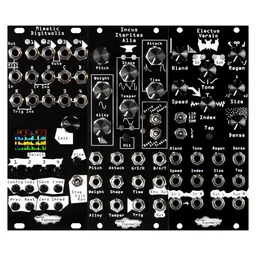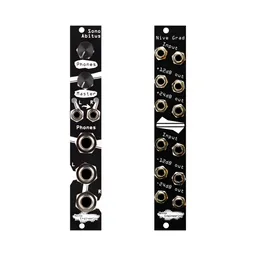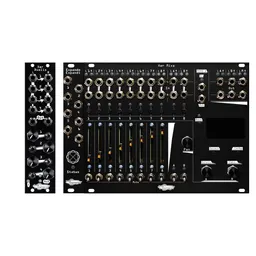Picking out your first modules? It can be a daunting prospect: there are thousands of modules from hundreds of manufacturers, and while that means that you can create a system to do pretty much anything you want, it also means that it can be hard to pick out your first few modules to start with. Last week, we picked out a case, and today, we’ll talk about some good places to start when choosing your first modules.
Noisebug’s all-NE system.
Wait, what do all these modules do?
This post is going to assume that you’re familiar with a lot of modular concepts, and focus more on balance and broad system concepts. However, we realize that that may not be the case: which is why we’re announcing the start of a whole new series here on the blog! Every few weeks, we’ll be posting a new article here about a modular concept, like envelopes, clocks, VCAs, and more. We’ll go in depth about what each type of module does, and how you can use it in your system. So if this post is still leaving you with questions, fear not! We’ll be addressing everything you could possibly want to know in the coming weeks.
Now, let’s build some systems!
Learn more:
What’s your goal?
When you think about buying an instrument, you think about the goal you want to achieve with it. You wouldn’t buy a drum kit if you really needed a bassline, right? And if you wanted that classic Moog synth sound, you’d probably buy a Moog synth (or perhaps a clone) and not a Juno. Modular synths allow you to build out your instrument however you like, but consider what the goal you’re looking to achieve is in advance. Do you want to make a case to make cool percussion? A little skiff for bizarre sound design? A box for external effects that you are going to have a blast with? A multipurpose synth that does it all? A great thing about modular synths is that you can build a case for any of these purposes, but it also means it is possible to put something together that you’re really unhappy with because it doesn’t do what you set out to do. If you have a reasonably specific idea of where you want to start, you’ll be better off while designing a case.
Achieving balance
In my opinion, aside from having fun, the most important thing to keep in mind with a small starter system is balance. By “balance”, I mean getting a set of modules that complement each other well, without too much redundancy or missing functions. When I started my system, I didn’t think about this a lot, and I struggled a bit with creating patches I really liked.
In a small system, you probably won’t want, for instance, six oscillators and one envelope. That’s not balanced. Your space will be much better dedicated to, for instance, two oscillators, two envelopes, and some filters and VCAs. Likewise, if you have a sequencer with no clock, you’ll be hard pressed to do, well, anything. Making sure that the modules you get have features that work well together will give you a much better patching experience.

It was a start to a long and noisy journey.
What’s an example of a real-life starter system?
If there’s a particular module that got you interested in Eurorack in the first place, or one that you’ve fallen in love with (we all have at some time or another), it’s a great idea to start with that, and get a module or two to complement it.
In case you missed last week’s post, Eurorack cases are measured in HP (which stands for horizontal pitch, and tells you how much space you have for modules in a row) and U: 3U is equal to a standard row of Eurorack modules. Why is 3U one row, you may ask? U is an abbreviation for rack units, and standard Eurorack modules are 3 rack units tall. You’ll want to make sure you get a case that you think will accommodate everything you want to put in it and do with it — again, more in last week’s post.
As an example, let’s go way, way back to the far-off land of 2016. I bought my first modules in 2016, and I still recall the terrifying feeling of trying to plug them all in for the first time. When I first started in Eurorack, I was extremely excited about the Hertz Donut MKII from Industrial Music Electronics. I bought that alongside a Pittsburgh Modular SV-1 to provide some utilities and extra goodies to create a full voice with it, and it was a lot of fun as a starter system.
I also started with a 3u x 84hp case (which extremely quickly grew into 6u x 84hp, then 12u… now I’m at 15u x 168hp and things have slowed down a little). I learned a lot in my first month of patching, and I’m glad I spent some time with those modules as they taught me a lot about Eurorack.
System 1: The Subtractor
We get a lot of people asking us for advice on what modules are right for them. But recently, friend of NE (and Noiseblast performer) composer Tiff Randol/IAMEVE wanted to build out a starter system. She wanted one-knob-per-function modules wherever possible, and sought some advice. After some back-and-forth asking what her goals with the system were, she wisely started with all the building blocks of a system separated out. It looked like this:
Click the picture to see the whole rack and learn more on Modulargrid.
As you can see, she started with a full voice (oscillator, filter, VCA, two envelopes) as well as some extra modulation (Clep Diaz) and effects (Desmodus Versio), and a MIDI-to-CV converter so she could control her setup with Ableton Live. She housed it in a Make Noise skiff so that it could fit anywhere in her studio. It’s an interesting system and I’ve been surprised by the massive range of results she’s gotten from it. In my opinion, this is a good example of a “balanced” starter system: a versatile sound source in the Loquelic Iteritas, a couple of ways to change that sound with the filter and reverb, and some modulation and dynamics to round things out.
The interesting thing about modular is that you can pick all the parts out to perfectly fit your taste. While that system includes some of my personal favorite modules, I would have chosen a different envelope module (I’m particularly fond of the Minimod Contour Generators) and a different modulation source (I really like the results I get from Mimetic Digitalis when paired with Loquelic Iteritas). Eurorack is all about preference, so really make your system yours!
System 2: Sequenced Space Farts
Now, let’s talk about another small system: this is based off of modules I use a lot. They’re not isolated like this in my own system, but they might as well be; I patch with them so much that I’ve thought about getting a separate case for them as a little jam system.

Click the picture to see the whole rack and learn more on Modulargrid.
There are only four modules: the Qu-Bit Bloom, the Mutable Instruments Stages, the Loquelic Iteritas Percido, and the Desmodus Versio. You’ll notice that, unlike the last system, there’s no VCA or filter here. The Loquelic Iteritas Percido is a full-voice version of the Loquelic Iteritas that we mentioned earlier, and it includes an envelope generator and VCA built-in. It’s also really good at generating a lot of different tones ranging from simple to complex (and modulating between the two) so it doesn’t always need a filter after it.
The Bloom is a recent addition to my system, and I’ve really enjoyed using it. It has a lot of sequencing possibilities: I tend to set up a short sequence -- sometimes as short as 5 steps -- and use its sequence modification parameters to evolve that into something completely new.
You’ll notice that this is another key difference between this system and the last: the Bloom is its own sequencer, contained within the system, instead of requiring an external controller like the other system does.
Stages is a fantastic utility for modulation -- I actually like it so much that I have three of them. It can create envelopes, sequences, LFOs, and a whole lot of other things, which can make it quite versatile in a small system like this. It does, however, require a bit of setup and it’s not always super immediate. Immediacy is something to consider when you put your system together: try to look for things that will fit your workflow. Modular is all about what you like. Preferences!
Lastly, we have the Desmodus Versio, our DSP platform. It really goes beyond normal reverb duties, so in a single-voice system like this it can really wake things up and act as a sort of voice or atmosphere-creation tool on its own. And, since it’s a DSP platform, it can be flashed with another firmware and turn into a completely different module, too.
All in all, that makes this relatively simple-looking system pretty deep, and it can do quite a few different things, even before you look at putting different firmware on the Desmodus Versio. I know that when I started I saw huge, wall-sized systems and assumed that I would need something like that to make interesting sounds. Not at all the case -- just a few modules can get you really, really far.
System 3: Who needs a sequencer when you’ve got two of these things?? *waves hands in the air*
Now, for this last system, let’s do something completely different:

Click the picture to see the whole rack and learn more on Modulargrid.
This is a really unusual system. These, again, are modules I use together in my system sometimes, if I just want to play with some samples and see what I can do with them in some more abstract patches. There’s no sequencing here: it’s all about hands-on control with the Lapsus Os, the time knob on the Pons Asinorum, and really anything else in the patch. The Nebulae lets us bring any kind of sound we want into the rack, and then manipulate it with the onboard granular capabilities and the other modules in the rack. This one isn’t designed for beats or melodies (unless we’re using samples of drums or melodic lines), it’s about experimenting with sounds, atmospheres, and frequencies. The Serge Resonant Equalizer is one of my favorite filter effects: it really reacts in interesting ways to whatever you feed into it, emphasizing, resonating, or completely removing frequencies. And Imitor Versio is a wild multitap delay that is, again, a lot of fun for experimentation and can really hold its own on top of other sonic elements.
Of course, there are near infinite case configurations that you could start out with, so why not look at some other systems? Ricky Tinez just put out a video talking about his current modular system. It’s got some familiar faces in it, and it’s housed in a 62 HP Intellijel Palette, too. Give it a watch here.
Hopefully, you’re now well on your way to building your first system. Remember: take it slow, ask lots of questions (we’re happy to help if you need some advice -- just drop us an email!), and don’t forget the patch cables! We’ll be back soon with another Getting Started post… stay tuned.








